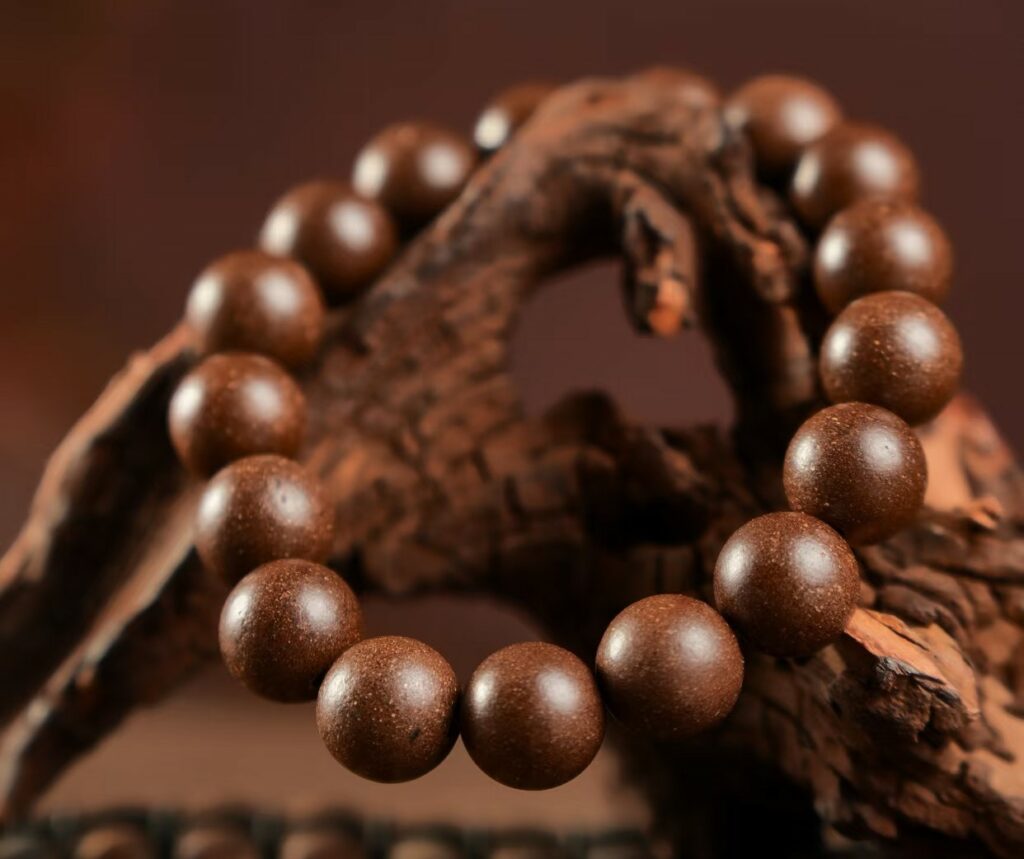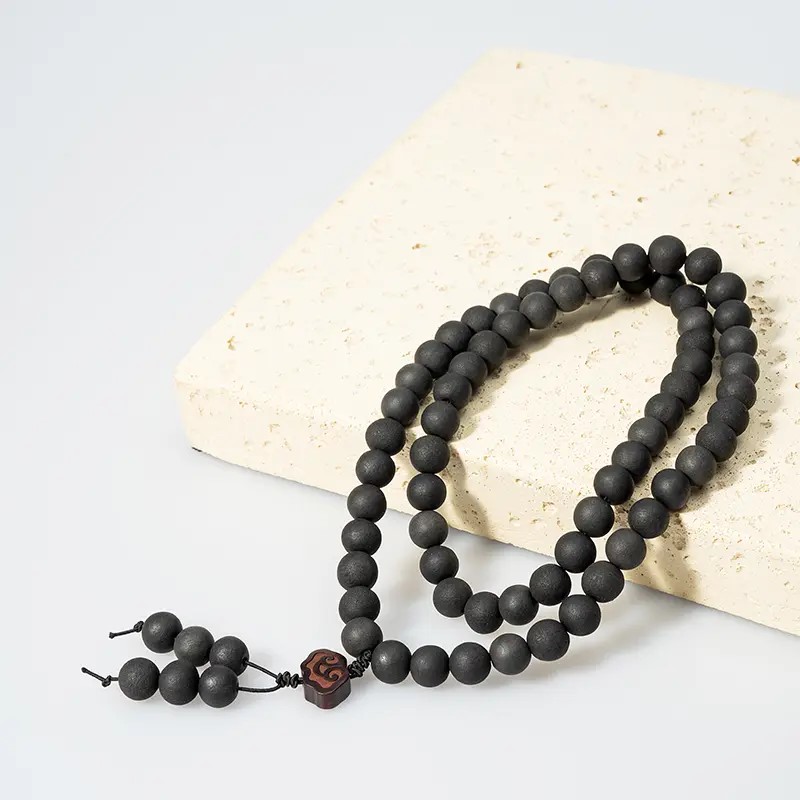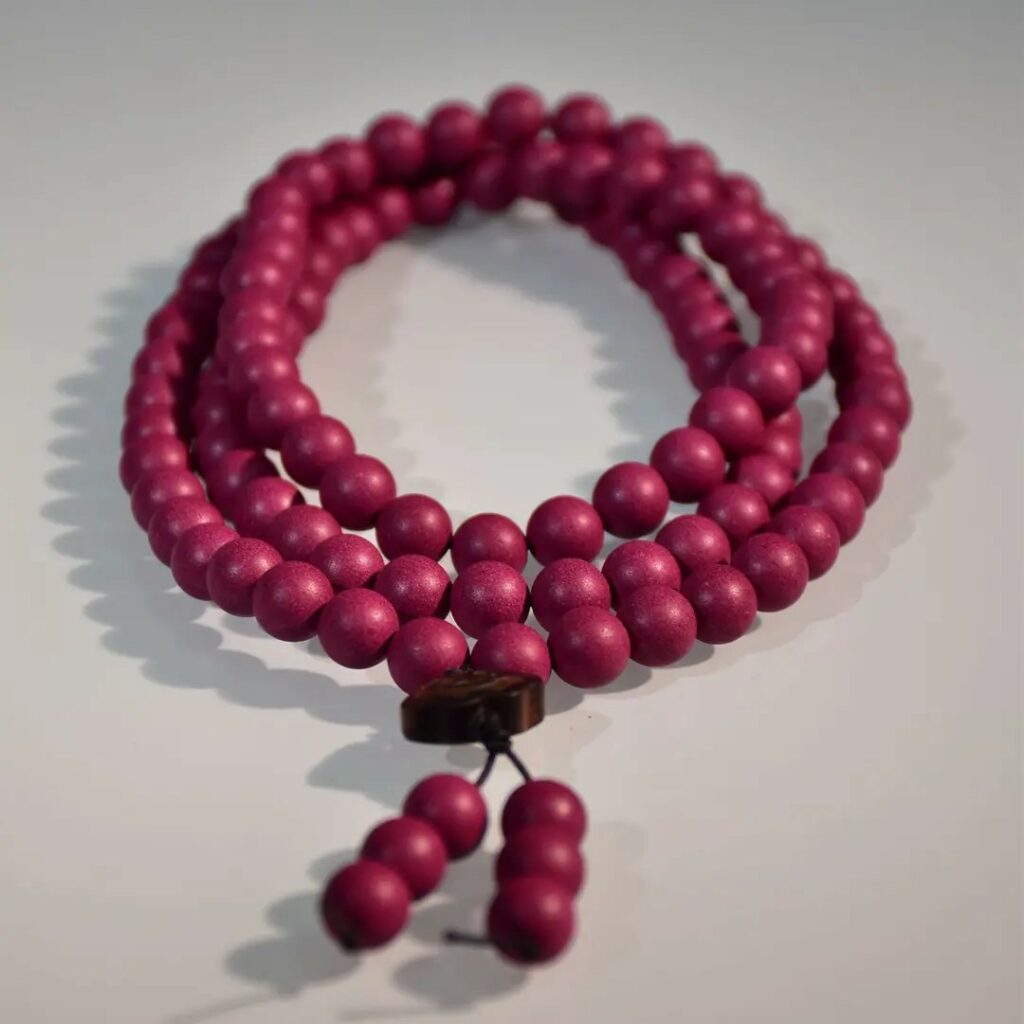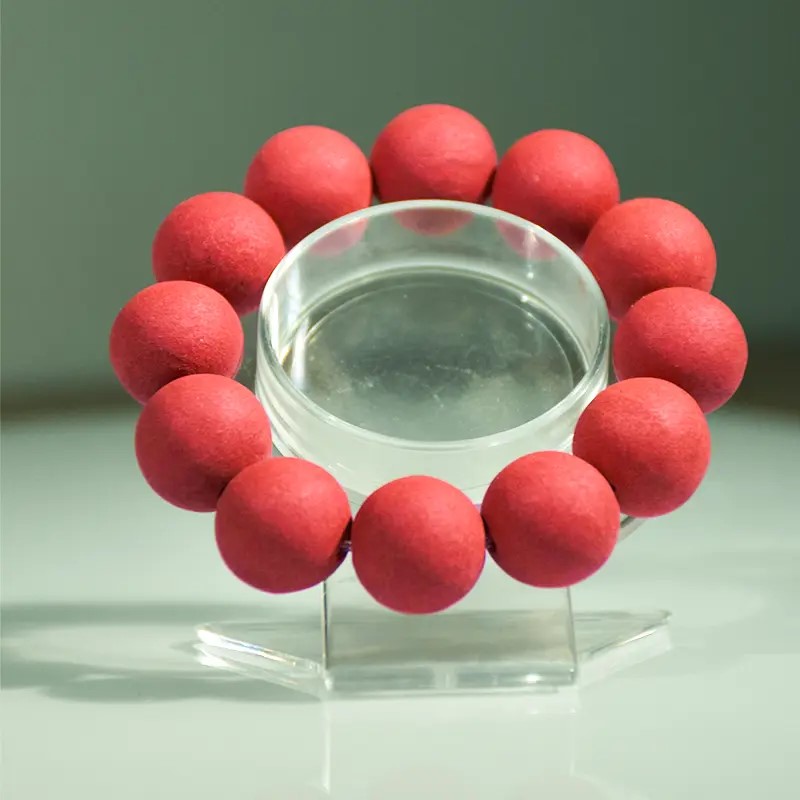The allure of Scented incense beads, or traditional Chinese composite incense beads, lies not just in their intricate fragrance but in the transformative journey they offer. More than mere adornment, these beads represent a confluence of material science, artisanal tradition, and mindful practice. The process of “Pan Wan”, or mindful handling, is the crucible where raw material evolves into a luminous artifact, mirroring the cultivator’s own inner refinement. This guide details the most scientifically grounded and spiritually resonant method for nurturing your Scented incense beads bracelet, emphasizing that true patination is a dialogue between time, chemistry, and conscious presence, fundamentally incompatible with haste.
Traditional Chinese Compound Incense
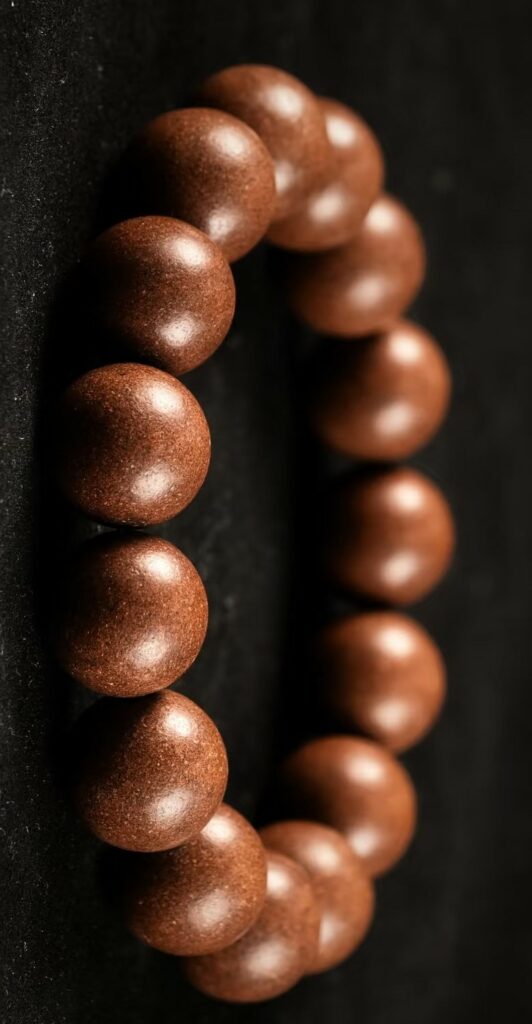
Traditional Chinese Compound Incense
The Delicate Art of Chinese aroma incense
Incense beads, or Chinese aroma incense beads , are far more than simple ornaments. These meticulously crafted spheres, born from the fusion of powdered precious woods, resins, herbs, and binding agents, represent a unique intersection of ancient Chinese fragrance culture, artistry, and contemplative practice. beads
- The Foundation: Understanding the Medium
Scented incense beads are complex composites. They typically blend powdered aromatic woods (sandalwood, agarwood, dalbergia), resins (frankincense, myrrh, benzoin), spices, and herbal powders bound with natural adhesives like plum paste or honey nectar. This porous, organic matrix reacts dynamically to its environment – light, oxygen, humidity, heat, and the subtle chemistry of human skin.
Material Science Insight: The initial surface is microscopically rough. Polishing (via cloth or glove) reduces friction, minimizes particulate shedding, and prepares the surface for subsequent interactions. Natural adhesives and resins are hygroscopic, meaning they absorb and release moisture from the air and skin. Oxidation processes are crucial for color development and patina formation. Sweat and skin oils, while potentially beneficial in minute, controlled amounts later, are initially destructive due to their salt content, acids (lactic acid), and organic compounds that can degrade binders, cause spotting, or accelerate uneven decomposition.
- The Methodical Path to Luminous Patina: A Scientific Protocol
- Phase 1: Surface Refinement & Initial Cleaning (7 Days)
Action: Employ a pristine, ultra-soft cotton flannel or undyed, lint-free microfiber glove. Gently roll and rotate the beads between your fingers and palm for 10-15 minutes, 2-3 times daily. Ensure even contact for all surfaces.
Science: This mechanical action removes any residual surface dust or loose particles from crafting. More crucially, it initiates a controlled smoothing through friction, compacting the outermost layer of the composite. This reduces the effective surface area and pore size slightly, creating a more uniform substrate. Cotton/flannel provides the ideal balance of mild abrasion and surface protection.
Mindful Focus: Observe the texture changing subtly. Feel the initial resistance giving way to smoother motion. This stage cultivates attention to detail and sensory awareness.
- Phase 2: Oxidative Seeding & Equilibrium Rest (3-5 Days)
Action: Place the bracelet in a breathable container (unbleached cotton pouch, untreated wooden box with air holes) within a consistently cool (18-22°C / 64-72°F), dark, and moderately dry (45-55% RH) environment. Avoid airtight containers, direct sunlight, heat sources, or damp areas.
Science: This rest period is critical for molecular reorganization.
Moisture Equilibrium: The beads, warmed and slightly compressed during Phase 1, release excess absorbed moisture evenly. Uniform drying prevents internal stresses and cracking.
Initial Oxidation: Exposure to ambient oxygen initiates slow, controlled oxidation reactions within the surface resins and aromatic compounds. This forms the nascent “Shang Ci” – a microscopically thin, harder, slightly glossy layer primarily composed of polymerized resins and oxidized compounds. It acts as a protective barrier and the foundation for patina. Darkness prevents UV degradation, which bleaches colors and weakens organic binders. Stable temperature/humidity prevents warping or uneven reaction rates.
Mindful Focus: Practice patience. Trust the unseen processes. This stage embodies the Daoist principle of Wu Wei – effortless action through non-interference.
- Phase 3: Controlled Biodynamic Interaction – Hand Panning (14 Days)
Action: With meticulously clean, completely dry, cool hands (wash with unscented soap, dry thoroughly, wait 10 mins), gently handle the beads. Roll, rotate, and caress them for approximately 30 minutes daily. Maintain a relaxed grip; pressure should be minimal. Focus on even coverage. Crucially: Stop immediately if hands feel even slightly damp or warm. Resume only when cool and dry.
Science: This is where human chemistry interfaces with the composite.
Micro-Deposition: Minute, controlled amounts of lipids (sebum) and amino acids from perfectly dry skin can begin to interact with the oxidized surface. These biocomponents, under ideal conditions, fill microscopic imperfections and, over immense time, contribute to depth and luster.
Friction & Heat: Gentle friction generates minimal localized heat, potentially aiding the polymerization of surface resins and the integration of skin-derived components. The key is minimal heat – excess accelerates reactions unevenly and risks sweat.
Barrier Integrity: The goal is to enhance the existing Shang Ci layer, not bypass it. Sweat (water, salts, acids) would dissolve this nascent layer, causing cloudiness, stickiness, or white salt efflorescence (“blooming”). Dry hands are non-negotiable.
Mindful Focus: Be fully present. Feel the cool smoothness of the beads. Note the subtle warmth generated by friction. Observe the very first hints of sheen. This is active meditation, connecting breath and touch.
- Phase 4: Polymerization & Patina Hardening (3-5 Days)
Action: Return the bracelet to its controlled resting environment (dark, cool, dry, breathable), identical to Phase 2.
Science: The micro-deposits and friction-altered surface need time to stabilize.
Polymerization: Resins and lipids continue slow cross-linking reactions, strengthening the surface layer.
Curing: Volatile components from skin interaction gently evaporate, leaving behind more stable compounds.
Hardening: The combined Shang Ci and initial patina layer densifies and hardens, becoming more resilient. This step ensures the patina integrates with the bead, not just sitting atop it.
Mindful Focus: Embrace the pause. Reflect on the subtle changes observed so far. This embodies the necessity of consolidation in any growth process.
- Phase 5: Iterative Refinement (Cycles of Phases 3 & 4 – Months/Years)
Action: Repeat the cycle of mindful hand panning (Phase 3) followed by rest (Phase 4). Frequency may decrease over time (e.g., hand panning sessions 2-3 times per week). Duration remains guided by hand dryness and bead response.
Science: Each cycle adds minuscule layers of integrated material and further compacts/polishes the surface. Oxidation continues at a deeper level. The result is a complex, multi-layered patina:
Optical Phenomenon: Multiple microscopic layers refract and scatter light differently than the raw surface. This creates depth, a soft inner glow (“Ling Qi”), and smoothness that approaches the tactile quality of fine jade or porcelain.
Chemical Evolution: Aromatics continue to mature and mellow. Resins become increasingly inert and stable.
Physical Transformation: The bead surface becomes significantly harder, smoother, and more resistant to environmental fluctuations.
Mindful Focus: Witness the gradual, profound transformation. The deepening color, the emerging glow, the glassy smoothness – these are tangible results of sustained, patient care. The bracelet becomes a mirror to your own cultivated calm and consistency.
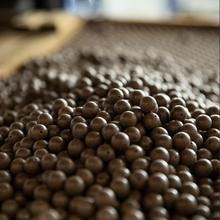

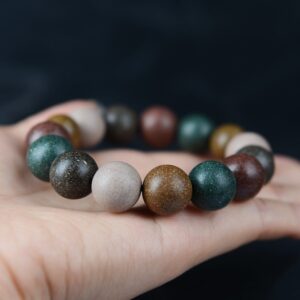
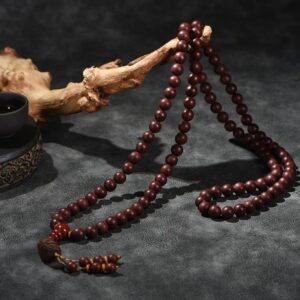
- Contingency: Addressing Accidents
Contamination (Dirt, Oils, Spills): Immediately cease handling. Do not rub. Use a barely damp microfiber cloth to very gently dab the affected area. Place immediately in the controlled rest environment for extended drying (1-2 weeks minimum). Expect a setback in patina development; patience is required to rebuild.
Water Exposure: Immediately blot excess moisture with a clean, absorbent cloth. Place in a very well-ventilated, dark, room-temperature area (NOT forced heat). Allow several weeks for complete, gradual drying before even considering resuming Pan Wan. Significant moisture can cause warping, binder degradation, or internal mold.
- The Alchemy Beyond Chemistry: Cultivating the Inner Landscape
The prescribed method is scientifically optimized for material integrity and aesthetic evolution. However, its true power lies in its parallel function as a mindfulness practice:
Discipline & Ritual: The structured routine fosters self-discipline. The requirement for clean, dry hands cultivates awareness of physical state and intentionality before action.
Present-Moment Awareness: Focusing on the tactile sensations – temperature, texture, friction – anchors attention firmly in the now, a core tenet of mindfulness.
Non-Attachment & Patience: The long timescales inherent in true patination directly challenge modern impulses for instant gratification. You learn to appreciate the process itself, finding joy in subtle, incremental change rather than fixating solely on an end result. The resting periods teach the value of stillness and non-doing.
Sensory Refinement: Handling the beads hones tactile sensitivity and visual discrimination. You learn to perceive minute variations in texture, sheen, and aroma that were previously imperceptible.
Reflection & Calm: The rhythmic, gentle motion and focused attention induce a calming, almost meditative state, reducing stress and fostering introspection. Observing the bead’s slow transformation becomes a metaphor for personal growth – gradual, requiring consistent care, and ultimately luminous.
The Patina of the Soul
The “most scientific” method for Pan Wan Scented incense beads transcends mere technical steps. It is a holistic discipline integrating material physics, organic chemistry, and profound mindfulness. By adhering to the principles of gentle mechanical preparation, controlled oxidation, meticulously clean and dry interaction, essential polymerization rests, and patient cyclical refinement, you optimize the conditions for the bead’s physical alchemy. Yet, the ultimate reward is not merely a bracelet of surpassing beauty with a deep, resilient patina and ethereal glow. It is the cultivated inner state – the patience, presence, discipline, and calm – forged through the consistent, mindful practice itself. In the slow dance of Pan Wan, both the composite incense bead and the practitioner are refined, emerging with a shared, luminous depth born of time, care, and quiet attention. The true patina, in the end, adorns the spirit.
